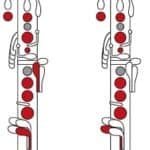If you listen closely to a great jazz clarinet solo, there is a moment where the line suddenly feels like it is flying but still locked to the beat, like a dancer landing perfectly on every step. That feeling often comes from a simple secret: the A bebop major scale, slipping through the keys of the clarinet like a whispered bit of club lore passed from one late-night rehearsal to the next.

Receive a free PDF of the chart with clarinet fingering diagrams for every note!
Clarinetists from Benny Goodman to modern players like Anat Cohen have leaned on this colorful pattern to make fast passages feel grounded, groovy, and clear. The A bebop major scale on Bb clarinet is more than a handful of notes. It is a way of thinking about time, swing, and storytelling in every register of your instrument.
The A bebop major scale on Bb clarinet is an 8-note jazz scale built from A major with an added chromatic note between the 5th and 6th degrees. It gives you smooth, swinging lines that place chord tones on strong beats and makes fast improvisation feel stable and musical.
How the A Bebop Major Scale Feels Under Your Fingers And In Your Ears
The A bebop major scale lives where clarity meets freedom. On paper, it is just an A major scale with one added passing tone. In sound, it is that classic straight-ahead jazz flavor that makes you think of crisp ride cymbal from Gene Krupa, a walking bass line from Ray Brown, and a clarinet line that lands every important chord tone right on the beat.
On Bb clarinet, you hear it a whole step lower than concert A, but you feel its pull toward bright harmony and rhythmic stability. The scale lets you race through eighth notes and still sound like you know exactly where the bar line is. That is why so many players practice bebop scales as daily ritual along with long tones, over-the-break slurs, and altissimo exercises.
The A bebop major scale uses 8 distinct scale degrees in each octave. That extra chromatic note helps clarinetists line up chord tones on strong beats during rapid eighth-note lines in swing and bebop tempos.
Clarinet Masters Who Lived Inside Bebop Lines
While the A bebop major scale is a theory term, the feeling behind it lives in countless recordings. Benny Goodman may be known as the “King of Swing,” but listen to his later small-group work, especially on tunes in A major and related keys, and you hear bebop language creeping into his lines. The extra chromatic passing note that defines bebop scales shows up in his solos as a natural extension of his classical training and his love of fast, clear articulation.
Buddy DeFranco took it much further. He made bebop clarinet his personal signature in the 1940s and 1950s, working with bands led by Tommy Dorsey and Art Blakey. Put on any of Buddy's recordings over standards in A major or D major and you will hear lines that outline the major tonality but are packed with bebop scale turns. That extra passing tone, especially between the 5th and 6th degrees, is right there in his arpeggiated sweeps and chromatic runs.
Artie Shaw flirted with bebop language too. On his later recordings and live broadcasts, you can pick out phrases that sound almost like textbook bebop major scale patterns, weaving around dominant chords and landing on strong chord tones. He bridged the smoother swing style of tunes like “Begin the Beguine” with more adventurous chromaticism that bebop scales help explain.
Modern clarinetists keep this vocabulary alive. Ken Peplowski, Ken Vandermark, and Eddie Daniels all draw on bebop motion even when they lean into modern harmony. Eddie Daniels in particular, on albums like “Breakthrough,” lets fast A major and A dominant lines fly with a clarity that could only come from serious time spent on bebop-style scales.
On the classical side, players such as Sabine Meyer, Martin Frost, and Richard Stoltzman may not speak in terms of “A bebop major” during a Mozart rehearsal, but the same logic appears in their phrasing. When they accelerate in a cadenza from Mozart's Clarinet Concerto or sprint through Weber's Concertino, they often use chromatic passing tones in a way jazz players would recognize instantly.
Where The A Bebop Major Color Hides In Iconic Pieces
Bebop scales are rarely written out in ink, but they are everywhere in the way clarinetists shape lines in real music. Think about these pieces and recordings as hidden classrooms for the A bebop major scale idea.
Start with jazz standards that land solidly in A major or neighboring keys.
- “All The Things You Are” often passes through A major-type sonorities. Listen to Buddy DeFranco's live takes, and you will hear bebop major scale fragments pivoting through modulations.
- “There Will Never Be Another You” frequently invites bright major passages. Ken Peplowski's solos feature climbed arpeggios and chromatic approaches that match bebop major thinking.
- Benny Goodman's performances of “After You've Gone” and “Shine” show how swing phrasing naturally leans into bebop style chromatic major lines, especially in the upper clarinet register.
Klezmer players like Giora Feidman and David Krakauer might not use the term “A bebop major scale,” but when they improvise over bright major chords in freilachs and bulgars in A, they use passing tones that fill in gaps in the major scale in a very similar way. The extra color note becomes a way to slide between clarinet throat tones and clarion fingerings with liquid ease.
Even film scores make use of these colors. When a clarinet section in the London Symphony Orchestra or the Berlin Philharmonic plays a jazz-tinged cue in A major, the orchestrator often writes stepped chromatic movement around dominant chords, the same shape that students later practice as an A bebop major scale on Bb clarinet.
| Piece or Style | How A Major Shows Up | Bebop Color In Practice |
|---|---|---|
| Swing & bebop standards | Solos over A major and E7 chords | Extra passing tone between 5th and 6th degree stabilizes fast eighth notes |
| Klezmer freilachs in A | Bright festival melodies on A clarion notes | Chromatic slides that mirror bebop major patterns |
| Film cues with jazz flavor | Clarinet section riffs in A major | Written scale runs that match bebop major motion |
From Baroque Chromaticism To Bebop Major Scales
The idea behind the A bebop major scale did not appear overnight in a smoky club. Its roots go back to baroque clarinet ancestors and even to chalumeau players exploring chromatic notes on early instruments. When composers like Johann Stamitz and Carl Stamitz began to write virtuosic clarinet concertos, they already loved fast diatonic scales punctuated with passing tones.
In the classical era, Anton Stadler, Mozart's clarinet muse, showed what was possible when you mix strong harmonic outlines with decorative chromatic notes. Listen to the slow movement of the Mozart Clarinet Concerto and imagine adding just one more chromatic step between two scale degrees. You are already thinking like a bebop player who wants every beat to land on a clear chord tone.
By the time Heinrich Baermann worked with Carl Maria von Weber on those fiery clarinet concertos, scales in A major were part of everyday practice. Chromatic runs spilled into cadenzas, and the idea that you could alter a scale slightly to better match a chord progression was taking shape, even if no one wrote “bebop major” above the staff.
In the 20th century, jazz theory finally gave this idea a name. Bebop players like Charlie Parker and Dizzy Gillespie noticed that if you add a passing tone to a 7-note scale, every strong beat in a stream of eighth notes can fall on a solid chord tone. Clarinetists like Buddy DeFranco, Tony Scott, and later Eddie Daniels took that principle and applied it across the clarinet's full range, from low chalumeau to bright altissimo.
Today, whether a player is in a conservatory practicing Brahms Clarinet Sonata in F minor or learning their first jazz standard on a student Bb clarinet, the same principle holds. A tiny tweak to a scale can open a clearer pathway through harmony. The A bebop major scale is one of those small adjustments that changes how your fingers and your ears think about time.
Why The A Bebop Major Scale Hits The Heart, Not Just The Metronome
There is something joyful about A major on clarinet. The open, ringing resonance of notes like written B, C# and high A on the clarion and altissimo keys makes the instrument sound like it is smiling. When you add the bebop passing tone into that major brightness, you get both sparkle and direction. Lines feel like they are always going somewhere.
Emotionally, the A bebop major scale gives you:
- Confidence, because your ear hears the chord tones landing right where they should.
- Lightness, because the major tonality carries a natural optimism.
- Playfulness, because the extra passing tone invites little turns, neighbor notes, and swung patterns.
If you have ever felt lost in the rapid-fire middle of a solo, this scale can feel like a handrail. Every time your fingers sweep through that familiar pattern, the harmony lines up again. It is a bit like the first time a clarinet student finally masters going over the break. Suddenly, a whole new part of the instrument feels like home.
What The A Bebop Major Scale Can Do For Your Playing
For a beginner or advancing student, spending time with the A bebop major scale is like putting a spotlight on your relationship to time and articulation. It encourages you to practice clean tonguing between throat tones and clarion, to feel the way your left-hand index finger shifts between A, B, and C#, and to hear the difference between chord tones and passing notes.
For an experienced player, this scale is a direct bridge from technical drills to real improvisation. It prepares you to solo over tunes with A major or related dominant chords, to color a Gershwin melody, or to embellish a klezmer tune that leans on bright clarinet lines. It even helps classical players feel more secure in fast cadenzas that move through major harmonies with chromatic turns.
Practicing the A bebop major scale for just 5 to 10 minutes a day with a metronome and backing tracks can noticeably improve your time feel and articulation within a few weeks.
| Practice Focus | Timing | How Often |
|---|---|---|
| Slow A bebop major scale, legato | 2 to 3 minutes with long tones on top note | Every day |
| Eighth-note patterns with metronome | 3 minutes, gradually increasing tempo | 3 to 4 times per week |
| Improvised lines using only this scale | 2 to 4 minutes over a backing track | 2 to 3 times per week |
As you work, you can connect this practice to other material on the site, such as long tone approaches in our articles on tone development for Bb clarinet, scale work related to G major and D major fingering guides, and tips on smooth register changes from our clarinet break-crossing tutorials.
A Quick Fingering Glimpse Before You Grab The Chart
The full fingering chart will show you every note of the A bebop major scale on Bb clarinet, across registers, with clear diagrams. You do not need a long technical explanation here, but it helps to picture how the pattern flows through your instrument.
- Start in the chalumeau register with low A and B using your left-hand and right-hand basic fingerings, including the register key only when moving to clarion notes.
- Cross the break smoothly into clarion C#, D, and E using the standard left-hand pinky and index finger combinations.
- Use the added chromatic note between the 5th and 6th degrees as a chance to practice alternate fingerings where the chart suggests them.
As you climb higher, pay attention to how your right-hand ring finger and left-hand pinky share responsibilities on notes like F#, G, and A. The chart will be your visual guide. Treat each repetition of the scale like a short musical phrase, not just a ladder of pitch names.
| Pattern Type | Feeling On Clarinet | Best Used For |
|---|---|---|
| Straight A major scale | Even, classical, clear diatonic sound | Etudes, classical excerpts, basic technique |
| A bebop major scale | Swinging, grounded, chromatic color | Jazz lines, klezmer embellishment, film cues |
Key Takeaways
- The A bebop major scale on Bb clarinet adds one passing tone to A major, giving your fast lines swing and harmonic clarity.
- Listening to masters like Buddy DeFranco, Benny Goodman, and Eddie Daniels will show you how this sound lives in real solos.
- Practice the scale daily with the free fingering chart to connect your finger patterns, ear, and time feel in a musical way.
Frequently Asked Questions
What is the A bebop major scale on Bb clarinet?
The A bebop major scale on Bb clarinet is a version of the A major scale with one extra chromatic passing note between the 5th and 6th degrees. This creates an 8-note pattern that helps your eighth-note lines land chord tones on strong beats, which is perfect for jazz and swing improvisation.
Why should I practice the A bebop major scale as a clarinetist?
Practicing the A bebop major scale improves your sense of time, articulation, and connection to harmony. It prepares you for solos over standards in A major and related keys, helps with fast passages across the break, and teaches your ear to hear which notes feel stable and which ones are passing colors.
Is the A bebop major scale only useful for jazz clarinet?
While it is rooted in jazz, the A bebop major scale is valuable beyond that style. The chromatic passing note concept helps classical and klezmer players shape lines more expressively. It also supports film and pop playing where clarinetists need to blend classical tone with jazz-influenced phrasing.
How often should I include the A bebop major scale in my practice?
Including the A bebop major scale for 5 to 10 minutes a day is enough to feel progress within a few weeks. Combine slow, legato runs with faster eighth-note patterns and short improvised phrases. Consistency matters more than long sessions, especially for building reliable fingerings and time feel.
Can beginners use the A bebop major scale fingering chart?
Yes, beginners can absolutely use the chart. Start slowly, focus on clean tone and smooth register changes, and treat it like a musical etude rather than a dry exercise. As you become comfortable with A major, adding the bebop passing note will feel like a natural, fun extension of what you already know.





